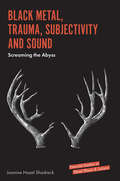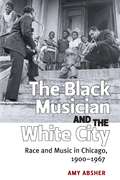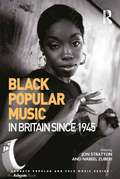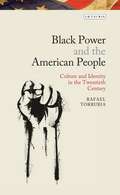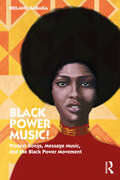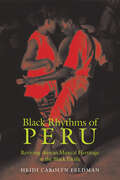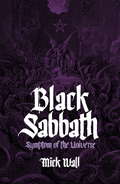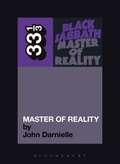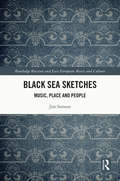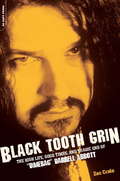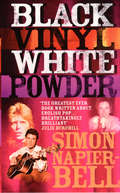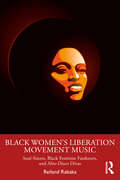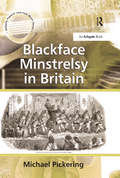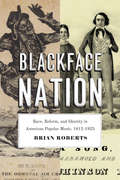- Table View
- List View
Black Metal, Trauma, Subjectivity and Sound: Screaming the Abyss (Emerald Studies in Metal Music and Culture)
by Jasmine Hazel ShadrackBlack Metal, Trauma, Subjectivity and Sound: Screaming the Abyss weaves together trauma, black metal performance and disability into a story of both pain and freedom. Drawing on her years as a black metal guitarist, Jasmine Hazel Shadrack uses autoethnography to explore her own experiences of gender-based violence, misogyny, and the healing power of performance. This profoundly personal book offers a detailed explanation of autoethnography, followed by a careful exposition of the relationship between metal and gender, considering - among other things - how women are engaged with by metal music culture. After examining the various waves of black metal and how this has impacted black metal theory, the book moves on to consider female performers and performance as catharsis, including a discussion of the author's work as guitarist and vocalist with the black metal band Denigrata and her alter-ego, the 'antlered priestess' Denigrata Herself. The book concludes with some thoughts on acquired disability, freedom and peace. The book includes a foreword from eminent gender researcher Rosemary Lucy Hill, a guest section from metal scholar Amanda DiGioia, an epilogue from Rebecca Lamont-Jiggens (a legal pracademic specialising in disability), suggestions of sources of help for those in abusive relationships and further reading for those wishing to learn more about black metal theory.
Black Music in Britain in the 21st Century (Liverpool Studies in the Politics of Popular Culture)
Since the turn of the 21st century, there have been several genres birthed from or nurtured in Black Britain: funky & tribal House, Afrobeats, Grime, Afro Swing, UK Drill, Road Rap, Trap etc. This pioneering book brings together diverse diasporan sounds in conversation. A valuable resource for those interested in the study of 21st century Black music and related cultures in Britain, this book goes incorporates the significant Black Atlantean, global interactions within Black music across time and space. It examines and proposes theoretical approaches, contributing to building a holistic appreciation of 21st century Black British music and its multidimensional nature. This book proffers an academically curated, rigorous, holistic view of Black British music in the 21st century. Drawing from pioneering academics in the emerging field and industry professionals, the book will serve academic theory, as well as the views, debates and experiences of industry professionals in a complementary style that shows the synergies between diasporas and interdisciplinary conversations. The book is interdisciplinary. It draws from sociology, musicology and the emerging digital humanities fields, to make its arguments and develop a multi-disciplinary perspective about Black British music in the 21st century.
The Black Musician and the White City: Race and Music in Chicago, 1900-1967
by Amy AbsherAmy Absher’s The Black Musician and the White City tells the story of African American musicians in Chicago during the mid-twentieth century. While depicting the segregated city before World War II, Absher traces the migration of black musicians, both men and women and both classical and vernacular performers, from the American South to Chicago during the 1930s to 1950s. Absher’s work diverges from existing studies in three ways: First, she takes the history beyond the study of jazz and blues by examining the significant role that classically trained black musicians played in building the Chicago South Side community. By acknowledging the presence and importance of classical musicians, Absher argues that black migrants in Chicago had diverse education and economic backgrounds but found common cause in the city’s music community. Second, Absher brings numerous maps to the history, illustrating the relationship between Chicago’s physical lines of segregation and the geography of black music in the city over the years. Third, Absher’s use of archival sources is both extensive and original, drawing on manuscript and oral history collections at the Center for Black Music Research in Chicago, Columbia University, Rutgers’s Institute of Jazz Studies, and Tulane’s Hogan Jazz Archive. By approaching the Chicago black musical community from these previously untapped angles, Absher offers a history that goes beyond the retelling of the achievements of the famous musicians by discussing musicians as a group. In The Black Musician and the White City, black musicians are the leading actors, thinkers, organizers, and critics of their own story.
Black Popular Music in Britain Since 1945 (Ashgate Popular and Folk Music Series)
by Jon Stratton Nabeel ZuberiBlack Popular Music in Britain Since 1945 provides the first broad scholarly discussion of this music since 1990. The book critically examines key moments in the history of black British popular music from 1940s jazz to 1970s soul and reggae, 1990s Jungle and the sounds of Dubstep and Grime that have echoed through the 2000s. While the book offers a history it also discusses the ways black musics in Britain have intersected with the politics of race and class, multiculturalism, gender and sexuality, and debates about media and technology. Contributors examine the impact of the local, the ways that black music in Birmingham, Bristol, Liverpool, Manchester and London evolved differently and how black popular music in Britain has always developed in complex interaction with the dominant British popular music tradition. This tradition has its own histories located in folk music, music hall and a constant engagement, since the nineteenth century, with American popular music, itself a dynamic mixing of African-American, Latin American and other musics. The ideas that run through various chapters form connecting narratives that challenge dominant understandings of black popular music in Britain and will be essential reading for those interested in Popular Music Studies, Black British Studies and Cultural Studies.
Black Popular Music in Britain Since 1945 (Ashgate Popular and Folk Music Series)
by Jon Stratton Nabeel ZuberiBlack Popular Music in Britain Since 1945 provides the first broad scholarly discussion of this music since 1990. The book critically examines key moments in the history of black British popular music from 1940s jazz to 1970s soul and reggae, 1990s Jungle and the sounds of Dubstep and Grime that have echoed through the 2000s. While the book offers a history it also discusses the ways black musics in Britain have intersected with the politics of race and class, multiculturalism, gender and sexuality, and debates about media and technology. Contributors examine the impact of the local, the ways that black music in Birmingham, Bristol, Liverpool, Manchester and London evolved differently and how black popular music in Britain has always developed in complex interaction with the dominant British popular music tradition. This tradition has its own histories located in folk music, music hall and a constant engagement, since the nineteenth century, with American popular music, itself a dynamic mixing of African-American, Latin American and other musics. The ideas that run through various chapters form connecting narratives that challenge dominant understandings of black popular music in Britain and will be essential reading for those interested in Popular Music Studies, Black British Studies and Cultural Studies.
Black Power and the American People: Culture and Identity in the Twentieth Century (Library of Modern American History)
by Rafael TorrubiaWhile the history of the Civil Rights Movement, from Rosa Parks to Martin Luther King, is one of the great American stories of the twentieth century, the related Black Power movement has left a more complex legacy. Its original leaders, Stokely Carmichael and Willie Ricks, were Black Nationalists, advocating a militant and extremist approach to tackle racism, while other leaders, such as Bobby Seale of the Black Panthers, believed that the struggle for Black Power was essentially a class struggle. Beginning with the folk-narratives told through song by slaves in the plantations, through the Harlem renaissance of the 1920s and 30s, the era of Malcolm X, the African-American art and fashion of the late sixties and 'soul music' and politics in the 1970s, Black Power and the American People will be the first comprehensive cultural history of the movement.
Black Power Music!: Protest Songs, Message Music, and the Black Power Movement
by Reiland RabakaBlack Power Music! Protest Songs, Message Music, and the Black Power Movement critically explores the soundtracks of the Black Power Movement as forms of "movement music." That is to say, much of classic Motown, soul, and funk music often mirrored and served as mouthpieces for the views and values, as well as the aspirations and frustrations, of the Black Power Movement. Black Power Music! is also about the intense interconnections between Black popular culture and Black political culture, both before and after the Black Power Movement, and the ways in which the Black Power Movement in many senses symbolizes the culmination of centuries of African American politics creatively combined with, and ingeniously conveyed through, African American music. Consequently, the term "Black Power music" can be seen as a code word for African American protest songs and message music between 1965 and 1975. "Black Power music" is a new concept that captures and conveys the fact that the majority of the messages in Black popular music between 1965 and 1975 seem to have been missed by most people who were not actively involved in, or in some significant way associated with, the Black Power Movement.
Black Power Music!: Protest Songs, Message Music, and the Black Power Movement
by Reiland RabakaBlack Power Music! Protest Songs, Message Music, and the Black Power Movement critically explores the soundtracks of the Black Power Movement as forms of "movement music." That is to say, much of classic Motown, soul, and funk music often mirrored and served as mouthpieces for the views and values, as well as the aspirations and frustrations, of the Black Power Movement. Black Power Music! is also about the intense interconnections between Black popular culture and Black political culture, both before and after the Black Power Movement, and the ways in which the Black Power Movement in many senses symbolizes the culmination of centuries of African American politics creatively combined with, and ingeniously conveyed through, African American music. Consequently, the term "Black Power music" can be seen as a code word for African American protest songs and message music between 1965 and 1975. "Black Power music" is a new concept that captures and conveys the fact that the majority of the messages in Black popular music between 1965 and 1975 seem to have been missed by most people who were not actively involved in, or in some significant way associated with, the Black Power Movement.
Black Rhythms of Peru: Reviving African Musical Heritage in the Black Pacific (Music / Culture)
by Heidi FeldmanWinner of the IASPM's Woody Guthrie Award (2007)In the late 1950s to 1970s, an Afro-Peruvian revival brought the forgotten music and dances of Peru's African musical heritage to Lima's theatrical stages. The revival conjured newly imagined links to the past in order to celebrate—and to some extent recreate—Black culture in Peru. In this groundbreaking study of the Afro-Peruvian revival and its aftermath, Heidi Carolyn Feldman reveals how Afro-Peruvian artists remapped blackness from the perspective of the "Black Pacific," a marginalized group of African diasporic communities along Latin America's Pacific coast. Feldman's "ethnography of remembering" traces the memory projects of charismatic Afro-Peruvian revival artists and companies, including José Durand, Nicomedes and Victoria Santa Cruz, and Perú Negro, culminating with Susana Baca's entry onto the global world music stage in the 1990s. Readers will learn how Afro-Peruvian music and dance genres, although recreated in the revival to symbolize the ancient and forgotten past, express competing modern beliefs regarding what constitutes "Black Rhythms of Peru."
Black Sabbath: Symptom of the Universe
by Mick WallThe final word on the only name synonymous with heavy metal - Black Sabbath.Way back in the mists of time, in the days when rock giants walked the earth, the name Ozzy Osbourne was synonymous with the subversive and dark. Back then, Ozzy was the singer in Black Sabbath, and they meant business. A four-piece formed from the ashes of two locally well-known groups called The Rare Breed (Ozzy and bassist Geezer Butler) and Mythology (guitarist Tony Iommi and drummer Bill Ward), all four founding members of the original Black Sabbath grew up within half-a-mile of each other.This biography tells the story of how they made that dream come true - and how it then turned into a nightmare for all of them. How at the height of their fame, Sabbath discovered they had been so badly ripped off by their managers they did not even own their own songs. How they looked for salvation from Don Arden - an even more notorious gangster figure, who resurrected their career but still left them indebted to him, financially and personally. And how it finally came to a head when in 1979 they sacked Ozzy: 'For being too out of control - even for us,' as Bill Ward put it.The next 15 years would see a war break out between the two camps: the post-Ozzy Sabbath and Ozzy himself, whose solo career overshadowed Sabbath to the point where, when he offered them the chance to reform around him again, it was entirely on his terms. Or rather, that of his wife and manager, daughter of Don Arden - Sharon Osbourne.
Black Sabbath and the Rise of Heavy Metal Music
by Andrew L. CopeThe definition of 'heavy metal' is often a contentious issue and in this lively and accessible text Andrew Cope presents a refreshing re-evaluation of the rules that define heavy metal as a musical genre. Cope begins with an interrogation of why, during the late 1960s and early 1970s, Birmingham provided the ideal location for the evolution and early development of heavy metal and hard rock. The author considers how the influence of the London and Liverpool music scenes merged with the unique cultural climate, industry and often desolated sites of post-war Birmingham to contribute significantly to the development of two unique forms of music: heavy metal and hard rock. The author explores these two forms through an extensive examination of key tracks from the first six albums of both Black Sabbath and Led Zeppelin, in which musical, visual and lyrical aspects of each band are carefully compared and contrasted in order to highlight the distinctive innovations of those early recordings. In conclusion, a number of case studies are presented that illustrate how the unique synthesis of elements established by Black Sabbath have been perpetuated and developed through the work of such bands as Iron Maiden, Metallica, Pantera, Machine Head, Nightwish, Arch Enemy and Cradle of Filth. As a consequence, the importance of heavy metal as a genre of music was firmly established, and its longevity assured.
Black Sabbath and the Rise of Heavy Metal Music
by Andrew L. CopeThe definition of 'heavy metal' is often a contentious issue and in this lively and accessible text Andrew Cope presents a refreshing re-evaluation of the rules that define heavy metal as a musical genre. Cope begins with an interrogation of why, during the late 1960s and early 1970s, Birmingham provided the ideal location for the evolution and early development of heavy metal and hard rock. The author considers how the influence of the London and Liverpool music scenes merged with the unique cultural climate, industry and often desolated sites of post-war Birmingham to contribute significantly to the development of two unique forms of music: heavy metal and hard rock. The author explores these two forms through an extensive examination of key tracks from the first six albums of both Black Sabbath and Led Zeppelin, in which musical, visual and lyrical aspects of each band are carefully compared and contrasted in order to highlight the distinctive innovations of those early recordings. In conclusion, a number of case studies are presented that illustrate how the unique synthesis of elements established by Black Sabbath have been perpetuated and developed through the work of such bands as Iron Maiden, Metallica, Pantera, Machine Head, Nightwish, Arch Enemy and Cradle of Filth. As a consequence, the importance of heavy metal as a genre of music was firmly established, and its longevity assured.
Black Sabbath's Master of Reality (33 1/3)
by John DarnielleBlack Sabbath's Master of Reality has maintained remarkable historical status over several generations; it's a touchstone for the directionless, and common coin for young men and women who've felt excluded from the broader cultural economy. John Darnielle hears it through the ears of Roger Painter, a young adult locked in a southern California adolescent psychiatric center in 1985; deprived of his Walkman and hungry for comfort, he explains Black Sabbath as one might describe air to a fish, or love to an android, hoping to convince his captors to give him back his tapes.
Black Sabbath's Master of Reality (33 1/3)
by John DarnielleBlack Sabbath's Master of Reality has maintained remarkable historical status over several generations; it's a touchstone for the directionless, and common coin for young men and women who've felt excluded from the broader cultural economy. John Darnielle hears it through the ears of Roger Painter, a young adult locked in a southern California adolescent psychiatric center in 1985; deprived of his Walkman and hungry for comfort, he explains Black Sabbath as one might describe air to a fish, or love to an android, hoping to convince his captors to give him back his tapes.
Black Sea Sketches: Music, Place and People (Slavonic and East European Music Studies)
by Jim SamsonBlack Sea Sketches is a portrait of some of the diverse musical cultures surrounding the Black Sea and in its hinterlands. Its six separate chapters follow a very broad trajectory from close-ups of traditional music (chapters 1-4) towards wide-angle studies of art music (chapters 5-6), and each of them opens windows to big, border-crossing themes about music and place. A wide variety of repertoires is discussed: ancient layers of polyphonic music, bardic songs, traditional music from the coasts and mountains, the sacred music of Islam and Orthodox Christianity, the art music of Europe and West Asia, and present-day popular music ‘scenes’. The usual practice is for each chapter to begin with a Black Sea coastal location before reaching out into the hinterlands. The result is a collection of six relatively discrete essays on different locations and topics, but with underlying thematic continuities, and offering a wide-ranging commentary on cultural difference. Firmly grounded in ethnographic and documentary research, this is an important study for scholars and researchers of Ethnomusicology, as also of Caucasian and Russian/East European Studies.
Black Sea Sketches: Music, Place and People (Slavonic and East European Music Studies)
by Jim SamsonBlack Sea Sketches is a portrait of some of the diverse musical cultures surrounding the Black Sea and in its hinterlands. Its six separate chapters follow a very broad trajectory from close-ups of traditional music (chapters 1-4) towards wide-angle studies of art music (chapters 5-6), and each of them opens windows to big, border-crossing themes about music and place. A wide variety of repertoires is discussed: ancient layers of polyphonic music, bardic songs, traditional music from the coasts and mountains, the sacred music of Islam and Orthodox Christianity, the art music of Europe and West Asia, and present-day popular music ‘scenes’. The usual practice is for each chapter to begin with a Black Sea coastal location before reaching out into the hinterlands. The result is a collection of six relatively discrete essays on different locations and topics, but with underlying thematic continuities, and offering a wide-ranging commentary on cultural difference. Firmly grounded in ethnographic and documentary research, this is an important study for scholars and researchers of Ethnomusicology, as also of Caucasian and Russian/East European Studies.
Black Tooth Grin: The High Life, Good Times, and Tragic End of "Dimebag" Darrell Abbott
by Zac CrainBlack Tooth Grin is the first biography of "Dimebag" Darrell Abbott, the Texas-bred guitarist of the heavy metal band Pantera, who was murdered onstage in 2004 by a deranged fan-24 years to the day after John Lennon met a similar fate.Darrell Abbott began as a Kiss-inspired teenage prodigy who won dozens of local talent contests. With his brother, drummer Vinnie Abbott, he formed Pantera, becoming one of the most popular bands of the '90s and selling millions of albums to an intensely devoted fan base. While the band's music was aggressive, "Dime" was outgoing, gregarious, and adored by everyone who knew him.From Pantera's heyday to their implosion following singer Phil Anselmo's heroin addiction to Darrell's tragic end, Black Tooth Grin is a moving portrait of a great artist.
Black Tooth Grin: The High Life, Good Times, and Tragic End of "Dimebag" Darrell Abbott
by Zac CrainBlack Tooth Grin is the first biography of "Dimebag" Darrell Abbott, the Texas-bred guitarist of the heavy metal band Pantera, who was murdered onstage in 2004 by a deranged fan-24 years to the day after John Lennon met a similar fate.Darrell Abbott began as a Kiss-inspired teenage prodigy who won dozens of local talent contests. With his brother, drummer Vinnie Abbott, he formed Pantera, becoming one of the most popular bands of the '90s and selling millions of albums to an intensely devoted fan base. While the band's music was aggressive, "Dime" was outgoing, gregarious, and adored by everyone who knew him.From Pantera's heyday to their implosion following singer Phil Anselmo's heroin addiction to Darrell's tragic end, Black Tooth Grin is a moving portrait of a great artist.
Black Vinyl White Powder
by Simon Napier-BellThe most authoritative, intelligent, diligently researched and unpretentious analysis of the British pop scene yet written' Sunday TelegraphBlack Vinyl White Powder charts the amazing fifty year history of the British music business in unparalleled scale and detail. As a key player across the decades, Napier-Bell - who discovered Marc Bolan and managed amongst others The Yardbirds and Wham! - uses his wealth of contacts and extraordinary personal experiences to tell the story of an industry that is like no other. Where bad behaviour is not only tolerated but encouraged, where drugs are sometimes as important as talent, where artists are pushed to their physical and mental limits in the name of profit and ego. 'The Greatest Ever Book Written about English Pop-Breathtakingly Brilliant' Julie Burchill'The cold print equivalent of a sparkling evening with a world-class raconteur.' Charles Shaar Murray, IndependentBitchy, glib, fun and shrewd' Daily Telegraph
Black Women's Liberation Movement Music: Soul Sisters, Black Feminist Funksters, and Afro-Disco Divas
by Reiland RabakaBlack Women’s Liberation Movement Music argues that the Black Women’s Liberation Movement of the mid-to-late 1960s and 1970s was a unique combination of Black political feminism, Black literary feminism, and Black musical feminism, among other forms of Black feminism. This book critically explores the ways the soundtracks of the Black Women’s Liberation Movement often overlapped with those of other 1960s and 1970s social, political, and cultural movements, such as the Black Power Movement, Women’s Liberation Movement, and Sexual Revolution. The soul, funk, and disco music of the Black Women’s Liberation Movement era is simultaneously interpreted as universalist, feminist (in a general sense), and Black female-focused. This music’s incredible ability to be interpreted in so many different ways speaks to the importance and power of Black women’s music and the fact that it has multiple meanings for a multitude of people. Within the worlds of both Black Popular Movement Studies and Black Popular Music Studies there has been a long-standing tendency to almost exclusively associate Black women’s music of the mid-to-late 1960s and 1970s with the Black male-dominated Black Power Movement or the White female-dominated Women’s Liberation Movement. However, this book reveals that much of the soul, funk, and disco performed by Black women was most often the very popular music of a very unpopular and unsung movement: The Black Women’s Liberation Movement. Black Women’s Liberation Movement Music is an invaluable resource for students, teachers, and researchers of Popular Music Studies, American Studies, African American Studies, Critical Race Studies, Gender Studies, and Sexuality Studies.
Black Women's Liberation Movement Music: Soul Sisters, Black Feminist Funksters, and Afro-Disco Divas
by Reiland RabakaBlack Women’s Liberation Movement Music argues that the Black Women’s Liberation Movement of the mid-to-late 1960s and 1970s was a unique combination of Black political feminism, Black literary feminism, and Black musical feminism, among other forms of Black feminism. This book critically explores the ways the soundtracks of the Black Women’s Liberation Movement often overlapped with those of other 1960s and 1970s social, political, and cultural movements, such as the Black Power Movement, Women’s Liberation Movement, and Sexual Revolution. The soul, funk, and disco music of the Black Women’s Liberation Movement era is simultaneously interpreted as universalist, feminist (in a general sense), and Black female-focused. This music’s incredible ability to be interpreted in so many different ways speaks to the importance and power of Black women’s music and the fact that it has multiple meanings for a multitude of people. Within the worlds of both Black Popular Movement Studies and Black Popular Music Studies there has been a long-standing tendency to almost exclusively associate Black women’s music of the mid-to-late 1960s and 1970s with the Black male-dominated Black Power Movement or the White female-dominated Women’s Liberation Movement. However, this book reveals that much of the soul, funk, and disco performed by Black women was most often the very popular music of a very unpopular and unsung movement: The Black Women’s Liberation Movement. Black Women’s Liberation Movement Music is an invaluable resource for students, teachers, and researchers of Popular Music Studies, American Studies, African American Studies, Critical Race Studies, Gender Studies, and Sexuality Studies.
Blackface Minstrelsy in Britain
by Michael PickeringBlackface minstrelsy is associated particularly with popular culture in the United States and Britain, yet despite the continual two-way flow of performers, troupes and companies across the Atlantic, there is little in Britain to match the scholarship of blackface studies in the States. This book concentrates on the distinctively British trajectory of minstrelsy. The historical study and cultural analysis of minstrelsy is important because of the significant role it played in Britain as a form of song, music and theatrical entertainment. Minstrelsy had a marked impact on popular music, dance and other aspects of popular culture, both in Britain and the United States. Its impact in the United States fed into significant song and music genres that were assimilated in Britain, from ragtime and jazz onwards, but prior to these influences, minstrelsy in Britain developed many distinct features and was adapted to operate within various conventions, themes and traditions in British popular culture. Pickering provides a convincing counter-argument to the assumption among writers in the United States that blackface was exclusively American and its British counterpart purely imitative. Minstrelsy was not confined to its value as song, music and dance. Jokes at the expense of black people along with demeaning racial stereotypes were integral to minstrel shows. As a form of popular entertainment, British minstrelsy created a cultural low-Other that offered confirmation of white racial ascendancy and imperial dominion around the world. The book attends closely to how this influence on colonialism and imperialism operated and proved ideologically so effective. At the same time British minstrelsy cannot be reduced to its racist and imperialist connections. Enormously important as those connections are, Pickering demonstrates the complexity of the subject by insisting that the minstrel show and minstrel performers are understood also in terms of their own theatrical dynamics, t
Blackface Minstrelsy in Britain
by Michael PickeringBlackface minstrelsy is associated particularly with popular culture in the United States and Britain, yet despite the continual two-way flow of performers, troupes and companies across the Atlantic, there is little in Britain to match the scholarship of blackface studies in the States. This book concentrates on the distinctively British trajectory of minstrelsy. The historical study and cultural analysis of minstrelsy is important because of the significant role it played in Britain as a form of song, music and theatrical entertainment. Minstrelsy had a marked impact on popular music, dance and other aspects of popular culture, both in Britain and the United States. Its impact in the United States fed into significant song and music genres that were assimilated in Britain, from ragtime and jazz onwards, but prior to these influences, minstrelsy in Britain developed many distinct features and was adapted to operate within various conventions, themes and traditions in British popular culture. Pickering provides a convincing counter-argument to the assumption among writers in the United States that blackface was exclusively American and its British counterpart purely imitative. Minstrelsy was not confined to its value as song, music and dance. Jokes at the expense of black people along with demeaning racial stereotypes were integral to minstrel shows. As a form of popular entertainment, British minstrelsy created a cultural low-Other that offered confirmation of white racial ascendancy and imperial dominion around the world. The book attends closely to how this influence on colonialism and imperialism operated and proved ideologically so effective. At the same time British minstrelsy cannot be reduced to its racist and imperialist connections. Enormously important as those connections are, Pickering demonstrates the complexity of the subject by insisting that the minstrel show and minstrel performers are understood also in terms of their own theatrical dynamics, t
Blackface Nation: Race, Reform, and Identity in American Popular Music, 1812-1925
by Brian RobertsAs the United States transitioned from a rural nation to an urbanized, industrial giant between the War of 1812 and the early twentieth century, ordinary people struggled over the question of what it meant to be American. As Brian Roberts shows in Blackface Nation, this struggle is especially evident in popular culture and the interplay between two specific strains of music: middle-class folk and blackface minstrelsy. The Hutchinson Family Singers, the Northeast’s most popular middle-class singing group during the mid-nineteenth century, is perhaps the best example of the first strain of music. The group’s songs expressed an American identity rooted in communal values, with lyrics focusing on abolition, women’s rights, and socialism. Blackface minstrelsy, on the other hand, emerged out of an audience-based coalition of Northern business elites, Southern slaveholders, and young, white, working-class men, for whom blackface expressed an identity rooted in individual self-expression, anti-intellectualism, and white superiority. Its performers embodied the love-crime version of racism, in which vast swaths of the white public adored African Americans who fit blackface stereotypes even as they used those stereotypes to rationalize white supremacy. By the early twentieth century, the blackface version of the American identity had become a part of America’s consumer culture while the Hutchinsons’ songs were increasingly regarded as old-fashioned. Blackface Nation elucidates the central irony in America’s musical history: much of the music that has been interpreted as black, authentic, and expressive was invented, performed, and enjoyed by people who believed strongly in white superiority. At the same time, the music often depicted as white, repressed, and boringly bourgeois was often socially and racially inclusive, committed to reform, and devoted to challenging the immoralities at the heart of America’s capitalist order.
Blackface Nation: Race, Reform, and Identity in American Popular Music, 1812-1925
by Brian RobertsAs the United States transitioned from a rural nation to an urbanized, industrial giant between the War of 1812 and the early twentieth century, ordinary people struggled over the question of what it meant to be American. As Brian Roberts shows in Blackface Nation, this struggle is especially evident in popular culture and the interplay between two specific strains of music: middle-class folk and blackface minstrelsy. The Hutchinson Family Singers, the Northeast’s most popular middle-class singing group during the mid-nineteenth century, is perhaps the best example of the first strain of music. The group’s songs expressed an American identity rooted in communal values, with lyrics focusing on abolition, women’s rights, and socialism. Blackface minstrelsy, on the other hand, emerged out of an audience-based coalition of Northern business elites, Southern slaveholders, and young, white, working-class men, for whom blackface expressed an identity rooted in individual self-expression, anti-intellectualism, and white superiority. Its performers embodied the love-crime version of racism, in which vast swaths of the white public adored African Americans who fit blackface stereotypes even as they used those stereotypes to rationalize white supremacy. By the early twentieth century, the blackface version of the American identity had become a part of America’s consumer culture while the Hutchinsons’ songs were increasingly regarded as old-fashioned. Blackface Nation elucidates the central irony in America’s musical history: much of the music that has been interpreted as black, authentic, and expressive was invented, performed, and enjoyed by people who believed strongly in white superiority. At the same time, the music often depicted as white, repressed, and boringly bourgeois was often socially and racially inclusive, committed to reform, and devoted to challenging the immoralities at the heart of America’s capitalist order.
